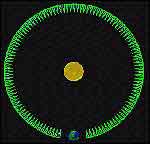
General Simon Worden of the United States Space Command described it as a "near-Earth object that is close to being trapped by the Earth as a second natural satellite".
According to Helena Morais of the University of Lisbon and Allesandro Morbidelli of the University of Nice, writing in a paper to be published in the journal, Icarus: "2002 AA29 seems to be in a temporary horseshoe-like orbit with the Earth."
This puts 2002 AA29 is in the same class as 3753 Cruithne, a similar rocky body in a horseshoe orbit around the Earth. But astronomers classify 2002 AA29 as the first real co-orbital body found associated with the Earth because it more completely shares the Earth's path around the Sun.
Co-orbiting asteroids have been found around other planets.
(two objects Co-orbiting in the same location, is a fact. We just haven't fond a planet size Co-orbiter yet. Or have we?)
"It is clear that 2002 AA29 was discovered by accident at a time when it was at one end of its horseshoe orbit and, being at its closest to the Earth, was bright enough to be detected in an automated sky survey.
Detailed observations of its trajectory through space show that 2002 AA29 will reach its minimum close approach to the Earth - 12 times the distance between Earth and the Moon - at 1900 GMT on 8 January 2003.
Cat-and-mouse game" (Planets don't play Cat and Mouse!)
"Thereafter it will travel ahead of the Earth moving faster than our planet does, until after 95 years it will catch up with the other side of the Earth and then reverse its motion." (Reverse its motion? Why?)
There must be something that is acting on, or affecting its orbit. The horseshoe idea is to make us think that it is closer to us then it is. That way we can except that it is an asteroid. I think it is more likely to be a moon around this other planet, and what looks like, it is reversing its orbit, is really just it making its normal rotation around its home planet.
In the 1800's, during the search for planet Vulcan, several times it was thought to have been seen, and then it despaired. It's likely they had seen one of the moons. Perhaps it would be appropriate to name one of these moons Vulcan, in recognition to the people who spent so much of there time looking."
Now let's talk about the present. How about NASA? Is there anything more they can tell us about this other planet?






